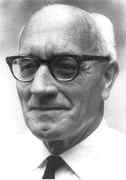Person: Room, Thomas Gerald

Thomas Room was an Australian mathematician who is best known for the invention of the so-called Room square.
Mathematical Profile (Excerpt):
- Thomas was brought up in various homes around London, in Camberwell, East Dulwich and Dulwich Village.
- Music played a special part in Room's life and while he was at Alleyn's School he sang in the school choir.
- Returning to Cambridge in 1927 saw Room take up his fellowship at St John's College but in 1928 he was appointed as a University Lecturer.
- One distinguished participant recalls of Room that 'On such occasions most of us were properly dressed, but he often used to rush in, rather later, with shorts revealing bare knees because he, as a Scout-master, had been out with his boys'.
- Although Room held his fellowship and lectureship for a year, in 1929 he gave up the fellowship to concentrate totally on the University lectureship.
- Lyons took sabbatical leave in 1933 which he spent at Cambridge working with H F Baker and at this time he became acquainted with Room.
- Room took charge of the small department at Sydney in which he had only five others to help him, with two of these being temporary.
- Shortly after his marriage, Room published the book The Geometry of Determinantal Loci (1938) which he had been working on for fifteen years.
- The book owed a great deal to Henry Baker and his geometry school at Cambridge but in the Introduction Room also notes that Richard Lyons had made a major contribution in the preparation of the book.
- It contained much that Room had published in papers during the 1930s such as: The freedoms of determinantal manifolds (1933); Notes on determinantal manifolds (I): pairs of determinantal manifolds of which one is a projection of the other (1934); Notes on the determinantal manifolds (II): the normal spaces of the manifolds represented by the vanishing of minors of highest order, and of order 2 in a matrix of linear forms (1935); Notes on determinantal manifolds (III): the genera of curves and surfaces represented by the vanishing of minors of highest order and of order 2 in a matrix of linear forms (1935); and Notes on determinantal manifolds (IV): the numerical genus of the manifold represented by the vanishing of minors of highest order in a matrix of linear forms (1936).
- It appears, however, that a small cypher section at Sydney University began working in January 1940 with Room and Lyons being the first two to become involved.
- Although it has not been confirmed, it is thought that Gordon Welchman may have played a role in the formation of this group for he knew Room, both of them being in H F Baker's group at Cambridge in the 1930s.
- As one of the first to be recruited to Bletchley Park where the codebreaking operations were being conducted, Welchman played important roles in recruiting fellow mathematicians to Bletchley but may well have recruited Room to set up the University of Sydney group.
- The codebreakers in Sydney, led by Room, worked on decoding Japanese messages.
- Within a few weeks, Room and Lieutenant Jamieson were sent to Bandung (Java) to study the techniques used by the Dutch and to Singapore to study the work of the British at the Far Eastern Combined Bureau.
- In March 1942 the Americans and Australians cooperated in a joint intelligence section in Brisbane called the Central Bureau and Room moved there where he worked on breaking Japanese codes until the end of the war.
- When the war ended Room returned to the University of Sydney where life became difficult because there was a large number of students.
- In March 1946 the University decided to appoint Keith Bullen to a Chair of Applied Mathematics and Room was pleased that a second professor was to be appointed.
- Room became head of Pure Mathematics and Keith Bullen became head of Applied Mathematics.
- Room was bitterly opposed to the splitting of the Department of Mathematics, believing strongly that mathematics was a unified subject.
- Bullen, however, had argued vigorously for the split and relations between Room and Bullen remained cool for the rest of their careers.
- By nature Room was a rather private person, who rarely showed his inner feelings in public.
- Room served as Dean of the Faculty of Science from 1952 to 1956 and again from 1960 to 1965.
- One other achievement for which he is known today by many is his introduction of "Room squares" in the paper A new type of magic square (1955).
- Robert Richard Anstice had constructed an infinite number of Room squares a hundred years before Room wrote his paper.
- For many years it was thought that the squares first appeared in Room's paper so they were named for him.
- In 1941 Room was awarded the Thomas Ranken Lyle Medal by the Australian National Research Council and in the same year he was elected a fellow of the Royal Society of London.
- In 1968 Room retired from his professorship at the University of Sydney.
Born 10 November 1902, Camberwell, London, England. Died 2 April 1986, St Ives, Sydney, Australia.
View full biography at MacTutor
Tags relevant for this person:
Origin England
Thank you to the contributors under CC BY-SA 4.0! 

- Github:
-

- non-Github:
- @J-J-O'Connor
- @E-F-Robertson
References
Adapted from other CC BY-SA 4.0 Sources:
- O’Connor, John J; Robertson, Edmund F: MacTutor History of Mathematics Archive
